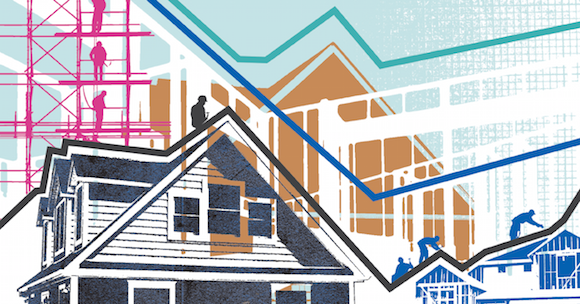 In mid-March, Freddie Mac released its 2015 outlook. The picture was rosy: Len Kiefer, the company’s chief deputy economist, said that home sales would be their most robust since 2007. By June’s end, said Freddie, expect 40 percent of the year’s closings.
In mid-March, Freddie Mac released its 2015 outlook. The picture was rosy: Len Kiefer, the company’s chief deputy economist, said that home sales would be their most robust since 2007. By June’s end, said Freddie, expect 40 percent of the year’s closings.
The longer-range outlook is positive, too. The NAHB and the Demand Institute say that 8.3 million new households will form over the next five years. Research by Zillow and Pulsenomics indicates that more than 5 million renters plan to buy homes this year.
Builders are feeling it.
“I’m very bullish,” says Doug Bauer, CEO of TRI Pointe Homes, in Irvine, Calif. He cites the “huge household growth” predicted for the next five to 10 years and its domino effect, creating a growing tier of move-up buyers. “Our business is cyclical,” Bauer acknowledges. “But what drives housing is household formation,” and that’s looking really strong right now, he insists.
It’s not just public builders who are bullish. Don Dykstra, president of Bloomfield Homes, cites similar positive stats, and this year, Bloomfield will build between 900 and 1,000 homes in the Dallas market. Jim Burbank, a partner with Saussy Burbank, in Raleigh, N.C., which builds in Charlotte, Raleigh-Durham, and Chapel Hill, N.C., as well as in Charleston, S.C., says, “We’re concerned about a lot of stuff, but right now the next downturn isn’t one of them.”
“We’re four or five years away from a meaningful dip or correction,” says George Murphy, president of Wayne Homes, which builds throughout Ohio, as well as in southeast Michigan, northeast Indiana, western Pennsylvania, and West Virginia. When the slide does come, says Murphy, it won’t be as profound as the last one. “That was a career moment,” he says, “and I’m not sure I have another one in me.” He stresses that keeping an eye out for leading indicators is key.
The year started strong. Long-term macroeconomics look promising. So does it really make sense to downshift when the road ahead looks smooth?
In a word, yes. Why? “In a hot market, many bankers turn high times into a rational argument and miss the psychology,” says Doug Wilson of Next Solutions, a longtime building industry consultant. “Dopamine in the brain gets you going,” Wilson says of the hormone tied to the brain’s pleasure centers. “It’s addictive.” (Wilson offers tips for staying smart in good times in "Hubris 101," below.) Though talk of a dip right now seems counterintuitive, not to mention a downer, a hot market may be exactly the moment to prepare for a cooler one.
“Counterintuitive is the way we think,” says Bob Goodall, president of Nashville, Tenn.-based Goodall Homes, Professional Builder’s 2014 Builder of the Year. When the market is at its worst, Goodall sees opportunity. When it’s at its best, he gets worried—as he is now about low inventory, low lot numbers, and the current “feeding frenzy.” About a year ago, he and his team decided to change a few land positions, diversify by adding one-level homes and condos for downsizers and boomers, and make sure that they had enough inventory for first-time buyers. “When the market is this hot, it’s just not healthy,” Goodall says. “One real estate guru around here says that the next dip will be where the market is right now.”
Jared Saint Aubyn, president of Saint Aubyn Homes, in Colorado Springs, Colo., agrees. “While Freddie Mac may be correct on a macro level, I don’t see much of an improvement over 2014,” he says. Though qualified homebuyer traffic is excellent, Saint Aubyn and his colleagues are handcuffed by labor and land shortages—hindrances that keep them from taking advantage of high demand and low interest rates. When rising interest rates and new-home prices hit a level where the consumer decides that the value isn’t there, we’ll see the dip, he predicts. In some places, he points out, it’s already happening.
Saun Sullivan, CEO of DSLD Homes, in Denham Springs, La., observes that banks are loosening up on business lending and wouldn’t be surprised if there were danger ahead. “We tend to have short memories in this business, and we tend to fight the last war,” he says.
Advice for Home Builders to Safeguard Against the Next Slowdown
Six tips from home builders that are taking steps to ensure their companies are prepared for a cooling market or deeper economic slowdown.
1] Short on Buyers? Home Builders Seek Renters
Most of the new supply is happening at the upper range, observes Bruce Percelay, chairman of The Mount Vernon Co., a Boston real estate investment firm. Percelay is playing defense, acquiring Class B assets that can be upgraded and that cost less than new construction. By targeting an underserved sector—the middle—he knows that whichever way the economy turns, he’s in a smart position. “We’re focusing on the renter by necessity instead of by choice,” Percelay says.
Big builders such as Lennar are taking a similar tack, with an entire division building for-rent communities, such as single-family project Frontera at Pioneer Meadows, in Sparks, Nev., and multifamily ones such as Skywater at Town Lake, in Tempe, Ariz. Toll Brothers is drawing renters from the higher-end at Parc Riverside, luxury rental apartment buildings in Washington, D.C., and Dulles Greene, outside the city in Herndon, Va. Tim O’Brien, president of Tim O’Brien Homes, serves the Milwaukee and Madison markets. He cites rentals as part of his long-range plan: a counter-cyclical safeguard for when the single-family market slows down again.
2] Home Builders Look to Product Diversity as Protection
Several single-family builders are expanding product lines to protect against a slowdown. Joel Mezistrano, CFO of American Classic Homes, in Mercer Island, Wash., is embarking on his first apartment and for-rent projects. American Classic is also making sure that it’s spread across submarkets and price ranges, targeting “suburbs, cities, and in between.” Commercial is another way to diversify, say Jalal and Mohammad Farzaneh, co-owners of Home Creations, which markets to first-time buyers in the Oklahoma City region. They use commercial properties as a safeguard to feed the home building side of the business.
3] Builders Check Their Balance Sheets and Focus on Building Liquidity
“Cash is always king during a downturn,” says Doug Smith, president of Miller & Smith, in McLean, Va. For him, safeguarding means seeking new relationships with outside partners. “Even if you don’t need the capital, a third party can poke holes in your assumptions, and it’s good to have their wisdom.” A fortressed balance sheet sounds obvious, but it was mentioned by many as a safeguard against an eventual slide.
4] Home Builders Keep a Close Eye on Sales Metrics and Listen to Salespeople
Joel Mezistrano and his partner, Robert Gladstein, cite being small as a benefit in keeping close tabs on what sales folks are saying. This has served Larry Webb well, too. The CEO of The New Home Co., in Aliso Viejo, Calif., says he has “always managed by paranoia” (a strategy also invoked by several other builders). “I get sales reports Sunday evening and traffic reports first thing Monday,” he says. “Market research permeates our entire company.”
5] Home Builders Pay Attention to Land Position
“You can’t run a business today and not think that way,” says Jim Burbank. “No ‘B’ locations—if things slow down, those seem to be the ones that go completely dead.” John Johnson, CEO of David Weekley Homes, in Houston, says that Weekley stays prudent with an asset-light business model. The firm, which builds in 19 cities and 11 states, conducts its sales as home builders, not land developers. “Each quarter, we buy five lots,” Johnson says, “and if the market turns off and things get really rough, we can honor our contract, forfeit our option deposit, and we’re not stuck with a bunch of lots.” During the last downturn, Weekley was able to back out thanks to those option agreements. “In a hot market it gets tempting to go buy that thousand acres, but you have to be disciplined,” Johnson insists.
6] Builders Make Sure They Get Costs in Check
Because of rising labor, land, and material prices, a builder’s ability to deliver to demand at a profit is compromised, says Scott Sedam, president of TrueNorth Development and a Professional Builder contributing editor. Sedam urges getting costs under control by eliminating waste (Sedam wrote about finding margin in the March and April 2015 issues, and in the May issue we well). “You can’t do it by pounding suppliers and trades,” he warns. “They can just go down the road and work for somebody else.”

Home Builder Hubris 101
Doug Wilson, president of Next Solutions, has been consulting for the housing industry for three decades. He says it’s time for a hubris check. “The biggest danger is the psychology of owners and CEOs,” he cautions. “Sales are up, people are making more money than they’ve made in seven years, and they feel as if they can do whatever it takes to beat the competition.” Optimism overwhelms caution, and it’s difficult to manage risk when profits are up and the path ahead looks clear. Here are five ways to stay smart when the going is good.
1. Surround yourself with voices of reason
Though senior members of your sales team may be whispering in your ear that now’s the time to take risks, push back against those who are pulling for aggressive growth and go for a more cautious approach. “Most of your sales team is incentivized for a percentage of the profit—they don’t have to pay it back if things go down,” Wilson says.
2. Plan for rough times in good times
The best moment to strategize for a tough cycle is when business is brisk, Wilson says. “The senior team should craft a strategy that they hold themselves and the rest of the organization accountable for.”
3. Take your leverage down
Four years ago, Wilson was telling builders to get out there and buy aggressively in preparation for an oncoming turnaround. Now he’s advising builders to buy entitled lots, get good terms, and beware of unentitled land, which can take you into the next downturn. If you are going to buy unentitled land, make sure it makes up no more than 15 percent of your overall portfolio, Wilson advises.
4. Seek equity partners now
To prepare for the next trough in the market, start building relationships with long-term capital sources and stay away from institutional capital. Find and cultivate alliances with high net-worth family offices, which will offer different terms from those offered by big investment firms. Forging new relationships now allows you to show potential investors what you’re capable of. “When the downturn hits, the two of you can go out and buy land at good prices,” Wilson says.
5. Ask for help
If you and your team can’t agree on what a solid balance sheet looks like, talk to your accountant. Consult CEOs from other markets and get an informed opinion on the facts. Just because banks are telling you that you qualify doesn’t mean that now’s the time to make a big commitment.













